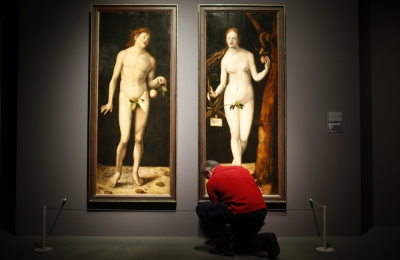
Data from the National Survey of Religious Leaders reveals that only 25% of Catholic and mainline Protestant pastors say they firmly believe in a literal Adam and Eve. Among Evangelical pastors, the numbers are somewhat better, but a notable portion still express doubt or uncertainty about whether Adam and Eve were real historical figures.
For some, this may seem like a minor theological point in the broader narrative of Scripture. But in truth, whether Adam and Eve were real people has profound implications for the authority of the Bible, the doctrine of original sin, the credibility of Jesus’ teachings, and the very foundation of the Gospel itself.
Genesis presents Adam and Eve not as metaphorical symbols but as literal individuals created uniquely by God. Genesis 2:7, ESV, says, “Then the Lord God formed the man of dust from the ground and breathed into his nostrils the breath of life, and the man became a living creature.”
This verse isn’t written in the style of myth or parable. It’s a clear and deliberate account of the origin of humanity. Later, in Genesis 2:22, the creation of Eve is described in similarly specific terms: “And the rib that the Lord God had taken from the man he made into a woman and brought her to the man.”
These are historical claims. The language of Genesis is unmistakably descriptive and personal. To treat Adam and Eve as fictional archetypes is to fundamentally alter the nature of the biblical narrative.
More troubling is the downstream effect this has on the rest of Christian doctrine. If Adam and Eve weren’t real, then there was no literal fall, no original sin, and therefore no need for a savior. The Apostle Paul grounds the need for redemption in the reality of Adam’s transgression.
In Romans 5:12, Paul writes, “Therefore, just as sin came into the world through one man, and death through sin, and so death spread to all men because all sinned.” He isn’t speculating or philosophizing. He’s building a theological argument based on a historical event.
The parallel Paul draws is between two real individuals: Adam, the first man, whose disobedience brought death, and Jesus Christ, the God-man, whose obedience brings life. Romans 5:19 says, “For as by the one man’s disobedience the many were made sinners, so by the one man’s obedience the many will be made righteous.” If Adam never lived, the structure of Paul’s Gospel message collapses.
This theological connection is not confined to Paul. Jesus affirmed the historicity of Genesis when he said, “Have you not read that he who created them from the beginning made them male and female?” (Matthew 19:4). Jesus’ reference to Adam and Eve used their creation to affirm the sanctity of marriage, rooting His teaching in the literal account of humanity’s beginning.
Luke also traces Jesus’ genealogy back to Adam (Luke 3:38), showing continuity from creation to Christ. To deny Adam and Eve’s existence is to sever that line and distort the biblical record.
Why do so many pastors, particularly mainline ministers, feel the need to reinterpret these foundational texts?
In many cases, it’s an attempt to reconcile the Bible with the theory of evolution and modern skepticism toward supernatural events. Many Christian universities and seminaries influenced by theological liberalism have long taught that the book of Genesis should be read symbolically rather than historically.
The intent may be to make Christianity more intellectually acceptable, but the result erodes the intended meaning of Scripture. When we begin to treat the Bible as metaphor wherever it conflicts with modern scientific theories, we lose any consistent basis for truth.
This is not an issue of science versus faith but an issue of scriptural authority. Proverbs 3:5 urges, “Trust in the Lord with all your heart, and do not lean on your own understanding.”
Once we begin selectively deciding which parts of the Bible are literal and which are symbolic based on cultural pressures, we are no longer submitting to the Word of God. We are placing ourselves above it.
James 3:1 warns, “Not many of you should become teachers, my brothers, for you know that we who teach will be judged with greater strictness.”
Those who stand in the pulpit bear a sacred obligation to teach God’s Word accurately and faithfully. Dismissing Adam and Eve as fictional may win praise from some intellectuals, but it misleads the flock and undermines the message of salvation. If we cannot trust the Bible’s first three chapters, why should we trust it at all?
A literal belief in the biblical account of Adam and Eve has significant pastoral implications. When congregants begin to believe that the Bible’s first man and woman are figurative, they inevitably start to question other parts of Scripture.
Doubt spreads like a virus. If the fall in Genesis is a myth, what about the literal resurrection of Jesus? If sin is just a metaphor for human imperfection, why did Jesus have to die? If there was no literal Adam, there is no literal sin or need for grace.
The NSRL data reflects this truism, as mainline Protestant clergy hold significantly lower levels of belief in core doctrines of historic Christianity compared to their Evangelical, Black Protestant, and Catholic counterparts. For example, just 70% of Episcopal, Methodist, and other mainline pastors say they have a sure belief in God, only 75% believe in the bodily resurrection of Jesus, and less than 50% believe in the existence of Hell.
When pastors say they are uncertain, even highly skeptical, of even the most foundational Christian doctrines, like God’s sovereignty, original sin, biblical authority, and human nature, there is no question that their congregants will quickly lose faith as well.
In a culture often hostile to biblical truth, we cannot afford to compromise on the fundamentals of our theology. Jesus said in John 17:17, “Sanctify them in the truth; your word is truth.”
This includes the creation of man and woman, as described in Genesis. Christianity is a faith rooted in real events: creation, fall, incarnation, crucifixion, and resurrection. If we strip it of its history, we remove its power.
We need pastors and church leaders who will stand firm and teach the whole counsel of God (Acts 20:27) without apology. We need churches that affirm the full truth of the Bible, from the first Adam to the second. Our nation needs believers who understand that denying a literal Adam and Eve doesn’t just challenge our understanding of ancient history but challenges the Gospel message.
This isn’t about winning a culture war or proving ourselves smarter than society’s skeptics. It’s about being faithful to what God has revealed. Adam and Eve were not myths. They were the first man and woman — created by God — through whom sin entered the world. Their story sets the stage for the greatest story ever told: the redemption of humanity through Jesus Christ.
That truth is worth believing — and defending.
Originally published at the Standing for Freedom Center.
Dillon Burroughs, Ph.D., writes for the Standing for Freedom Center and serves as an adjunct instructor at Liberty University’s John W. Rawlings School of Divinity. He lives with his wife and children in Chattanooga, Tennessee.

















